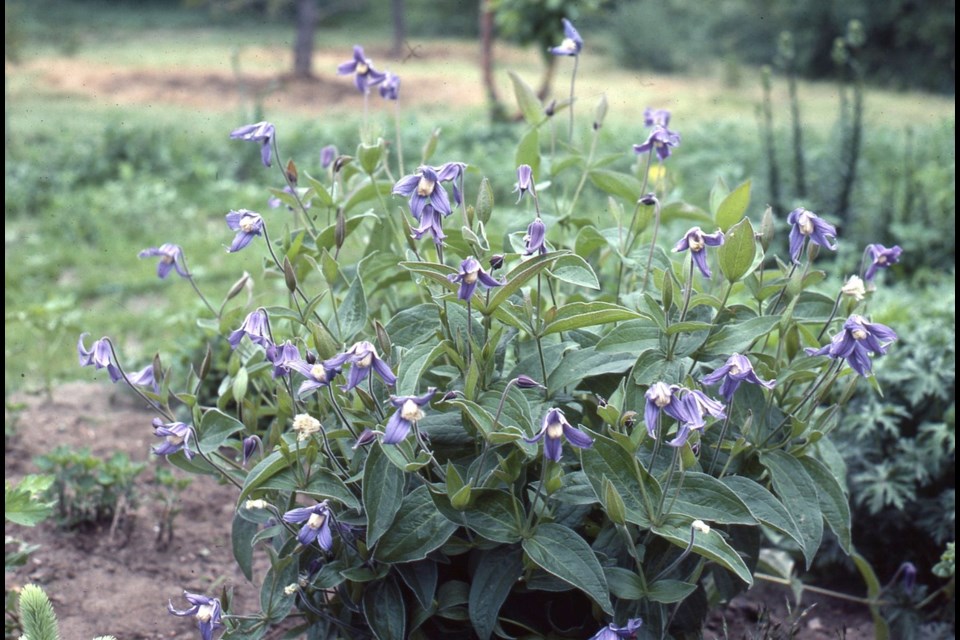Two types of clematis can be grown on the prairies – climbers and non-climbers. Most gardeners are familiar with the former. While some do well here, others need a great deal of coddling, coupled with your most protected microclimate and yet still may not survive. They share equal space on garden centres’ benches. So how does one know if the plant you’re considering will be hardy? Read the Latin names on the plant tags.
The hybrids of Clematis alpina and Clematis macropetala are among the loveliest, hardiest and easiest to grow. They vary from 2.6 to four metres (eight to 12 feet), climb using twining leaf stalks, and bloom from late spring to early summer on the previous year’s growth. They need little pruning unless blocking a window or an arbour. They benefit from deep, organically enriched soil, a 10-centimetres (four-inch) layer of mulch at their base and deep watering (to a depth of 45 centimetres/18 inches) every two weeks. Bloom is greatest in full sun.
The alpine clematis (Clematis alpina), native to Europe and Asia, has bell-shaped flowers in white, pink or blue, with each leaf consisting of three groups of three leaflets. Generally, two to 2.5 metres (six to eight feet) high, among the varieties are ‘Ruby’ with deep pink flowers, ‘Willy’ with pale pink flowers with a darker edge, ‘Constance’ with almost red flowers and ‘Francis Rivis’ and ‘Pamela Jackman’ with blue flowers.
The large petaled clematis (Clematis macropetela), native to China, is taller, between 3.6 and four metres (10 to 12 feet), with bell-shaped flowers. Many have been developed by prairie plant breeders. Frank Skinner introduced ‘Blue Bird’ with lavender-blue flowers, ‘Rosy O’Grady’ with long pink pointed sepals, and the snow white ‘White Swan’, while Stan Zubrowski’s ‘Joe Zary’ has double purple flowers.
Quite different from the above are hybrids of the herbaceous Clematis integrifolia and the climbing Clematis jackmanii. These begin growth each spring at ground level and climb to about three metres (nine feet), blooming on the current season’s growth in late summer. The roots survive, but the foliage is killed to soil level each winter and should be pruned off in early spring. One of the best is ‘Blue Boy’, introduced by Frank Skinner in 1947. A more recent introduction from Latvia is ‘Pamjat Serdsta’ with light violet flowers.
Herbaceous, non-climbing clematis are less well-known and not as readily available. They need a marketing agent and a propagation push by wholesale growers. From 0.6 to 1.3 metres (two to four feet) high, they’re generally blue or purple, long-lived, hardy and well-behaved. I’ve had some for more than 30 years and recommend them highly. Plant them in full sun or light shade in soil well amended with organic matter. Water them as you would most perennials. Remove the previous season’s dead foliage each spring.
The ground clematis (C. recta) is native to the hills and scrubland from southeast Europe to Russia. It’s one to 1.3 metres (three to four feet) high and covered with panicles of tiny 2.5-centimetre (one-inch), sweetly scented, star-shaped white flowers in mid-summer.
Mine conceals the lid of my septic tank. Planted adjacent to what you wish to conceal, gently bend it over once it’s about 18 inches high, placing a small log on top to keep it there. It soon forms a mound of sweetly scented flowers – much sweeter than the contents of your average septic tank. To access the tank, simply move the mass of flowers and foliage to the side.
Purple ground clematis (C. recta ‘Purpurea’) is similar but with purple foliage. The purpling varies and is more pronounced on younger foliage.
The Hungarian clematis (C. integrifolia), native to southern Europe and Asia, including Hungary, is about 60 centimetres (two feet) high with large, blue, nodding, bell- or urn-shaped flowers with white stamens. It blooms from late spring to late summer, becoming somewhat sprawling as the season progresses, and benefits when supported by a peony hoop.
The hairy or fern-leafed clematis (C. hirsutissima), native to the Great Plains, has much divided, almost fern-like, foliage covered with long silky hairs. It’s similar in size and flower characteristics to C. integrifolia, but blooms in spring. The blue flowers are followed by feathery seed heads. I obtained this in the mid-1970s from Bert Porter’s Honeywood Nursery and it’s been flourishing ever since. That’s fifty years! A truly lovely and rare plant, I’ve never seen another source for it. If you find it, grab it!
Sara Williams is the author of many books including Gardening Naturally with Hugh Skinner, Creating the Prairie Xeriscape, and with Bob Bors, Growing Fruit in Northern Gardens. She gives workshops on a wide range of gardening topics throughout the prairies.
This column is provided courtesy of the Saskatchewan Perennial Society (SPS; [email protected] ). Upcoming event - Spring Plant and Seed Exchange and Plant Sale Tuesday, May 30 6:30 p.m. at Saskatoon Forestry and Zoo Hall. Check our website (www.saskperennial.ca) for more details.




